Ah, the sight of droplets glistening at the tips of your beloved pothos plant! It’s quite the spectacle, isn’t it?
While many of us cherish our indoor greenery, noticing your pothos dripping water can be a tad disconcerting. Is my plant crying? Sweating?
Is it trying to tell me something? You’re not alone in this dilemma; it’s a common quandary many plant enthusiasts stumble upon.
Addressing this watery mystery isn’t just about putting your mind at ease—it’s crucial for the overall health of your pothos.
If you’ve been scratching your head, worrying about those tiny droplets and what they might mean, you’re in the right place.
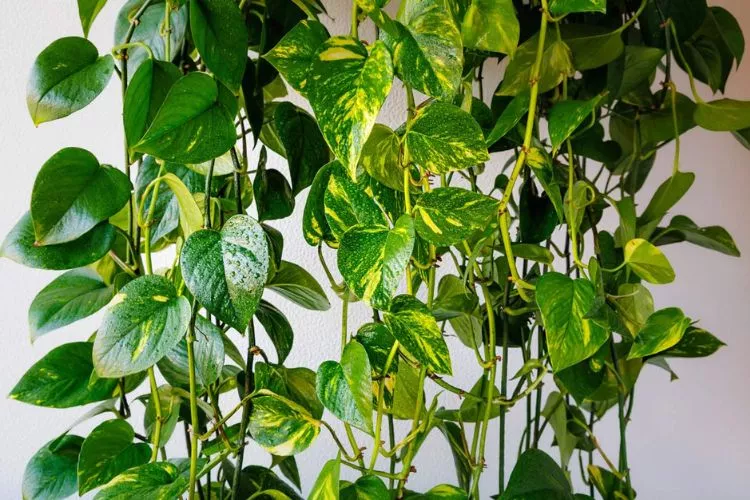
This article promises to unpack the reasons behind this phenomenon and provide actionable solutions.
Stick around, and let’s dive deep into the world of pothos and its mysterious tears. Your plant’s well-being (and perhaps yours!) might just depend on it.
Table of Contents
What is Pothos Dripping Water?
So, you’ve spotted those tiny droplets, like morning dew, clinging to the edges of your pothos leaves and you’re wondering, “What’s going on?” Let’s break it down.
At the heart of this dewy situation is a process known as guttation. Guttation is the plant’s way of exuding excess water from its system. This happens when the plant’s roots absorb more water than it can actually use.
Overnight, when transpiration (the evaporation of water from plant leaves) is low due to the absence of sunlight, the plant might push out this excess water through specialized structures on the leaf edges called hydathodes. Think of it as the plant’s version of morning dew.
Now, it’s essential to note that guttation isn’t the only reason your pothos might be dripping water. Another common culprit is overwatering.
But how do you differentiate the two? Guttation droplets tend to be tiny and appear primarily in the morning.
They will feel slightly sticky if you touch them since they contain a mix of water and nutrients. On the other hand, overwatering manifests as excessive moisture at the bottom of the plant, leading to yellowing leaves and a general sense of the plant being ‘too wet.’
Recognizing the difference between guttation and the signs of overwatering is crucial. While guttation is a natural process and not immediately harmful, overwatering can be detrimental to your pothos in the long run. It’s like giving your plant a water diet – balance is key!
5 Reasons for Pothos Dripping Water
Let’s embark on a botanical detective journey, shall we? If your pothos is leaving little water droplets behind, several factors might be playing their part.
While it’s easy to jump to conclusions and assume one particular reason, it’s more often a combination of elements working together.
Like any mystery, understanding the different players involved will get us closer to the solution. This section delves deep into the common causes, shedding light on the environmental and care practices that might lead to our pothos dripping its watery clues.
High Humidity
Ah, humidity – a word that’s often tossed around in the plant world, and for good reason. Pothos, like many tropical plants, originally hail from regions where humidity levels run high. However, in our modern homes, this atmospheric moisture can be a double-edged sword.
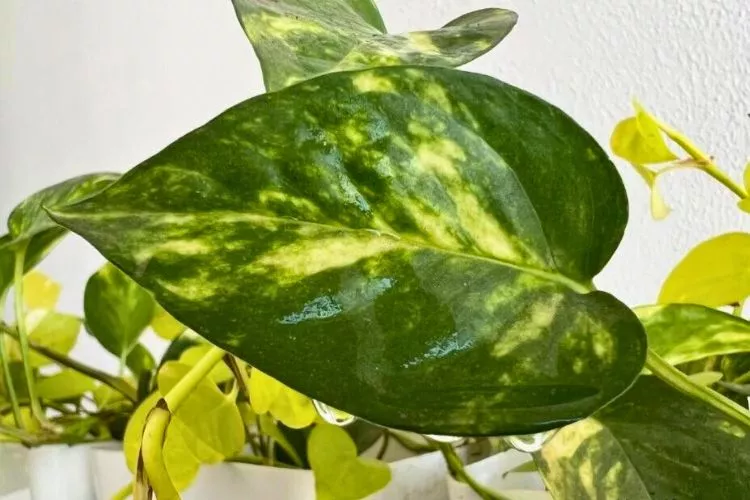
When the air around the pothos becomes too saturated with moisture, the plant finds it harder to transpire, i.e., release water vapor from its leaves. This is because the surrounding air is already brimming with moisture, leaving little room for the plant’s water vapor. As a result, what could have been a routine release turns into visible water drips on the leaf tips.
So, how can you strike a balance and maintain the right humidity for your green buddy?
- Regularly Monitor: Investing in a hygrometer can be invaluable. This handy device will help you keep track of the humidity levels in your space, letting you know if adjustments are necessary.
- Air Circulation: Ensure there’s good air circulation around your plant. A gentle breeze from an oscillating fan can help prevent moisture buildup on the leaves.
- Grouping Plants: Consider grouping your pothos with other plants. Plants naturally increase humidity around them, creating a microenvironment that’s beneficial for all. But remember, avoid overcrowding, which can limit airflow.
- Trays with Pebbles: Place your pothos pot on a tray filled with pebbles and a little water. As the water evaporates, it’ll increase humidity around the plant without over-saturating the roots.
Overwatering
Overwatering is perhaps one of the most common mistakes, even among seasoned plant enthusiasts. We often associate pouring more water with more care and love, but for our pothos, it might be a bit too much affection.
Let’s dive into the perils of overwatering and how it can make your pothos a little more tearful than you’d like.
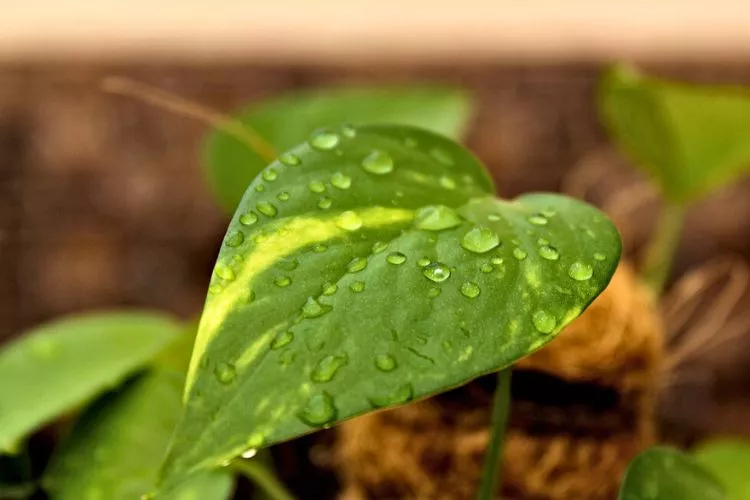
When pothos plants are doused with more water than their roots can absorb, they become overwhelmed. The excess moisture saturates the soil, making it harder for the roots to breathe.
Over time, this leads to root rot—a fungal condition that damages and kills plant roots. Once rot sets in, the plant’s ability to absorb water and nutrients gets compromised, which may lead to drooping leaves, yellowing, and of course, the ominous water drips.
So, how can you tell if you’re going overboard with your watering regime? Here are some signs:
- Soggy Soil: If the top inch of soil remains wet for several days, it’s a clear indicator of overwatering.
- Yellowing Leaves: While many factors can cause yellow leaves, when combined with damp soil, it’s often a sign of too much water.
- Mushy Roots: If you suspect overwatering, inspect the plant’s roots. Healthy pothos roots are white or light tan and firm. Dark and mushy roots spell trouble.
Now, how to keep from drowning your leafy friend?
- Stick to a Schedule: Rather than watering on a fixed routine, check the soil’s moisture. If the top inch is dry, it’s time for a drink.
- Ensure Proper Drainage: Always use pots with drainage holes. This ensures any excess water can escape, preventing waterlogged soil.
- Be Wary of Weather: During colder months or when there’s less sunlight, plants generally need less water. Adjust your watering routine according to the season.
Transpiration and Guttation
Ever thought of plants sweating? Well, in their own unique way, they kind of do! Let’s unravel two fundamental processes that plants, like pothos, employ to regulate water: transpiration and guttation.
These natural mechanisms, while essential for the plant’s health, can sometimes leave us wondering about those little droplets we see.
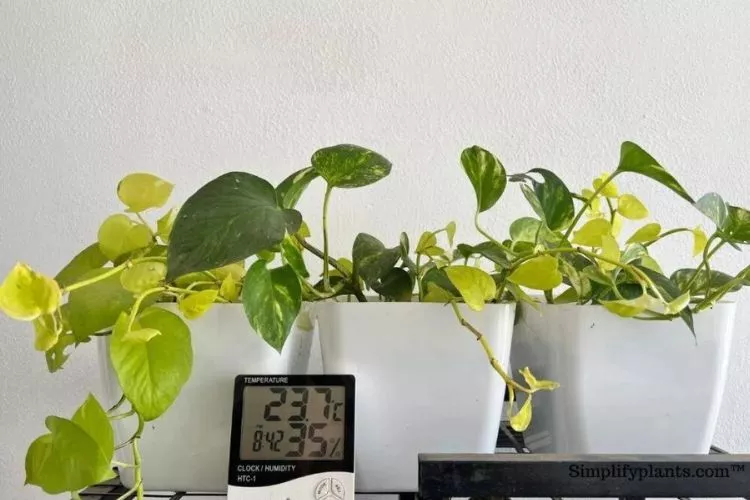
Transpiration is akin to plant perspiration. During the day, as the sun beams down, pothos leaves open their stomata (tiny pores) to take in carbon dioxide for photosynthesis.
As they do this, water vapor is released from these stomata into the atmosphere—a process that helps cool the plant and draws up essential nutrients from the roots. In a way, it’s the plant’s way of breathing and regulating its internal water balance.
Guttation, on the other hand, is more about expulsion than regulation. It usually occurs during the night or early morning when the soil is wet, and the surrounding air is humid.
Root pressure pushes water up, and when transpiration isn’t active (remember, it’s nighttime), the excess water is forced out through tiny veins at the leaf tips called hydathodes. These expelled droplets are more than just water—they often contain dissolved nutrients, giving them a slightly sticky feel.
So, how do these processes lead to water dripping from pothos leaves?
- Ambient Conditions: On humid days or after a thorough watering, transpiration might not be sufficient to offload all the absorbed water. Guttation kicks in, especially during the night, leading to those telltale droplets by dawn.
- Inefficient Transpiration: If a pothos is placed in a low-light condition, its rate of transpiration might decrease. Reduced transpiration combined with regular watering can amplify guttation.
- Overfeeding: If you’ve been a tad generous with plant food or fertilizers, the increased minerals can amplify guttation as the plant tries to expel the excess.
Understanding these processes helps demystify those water droplets, whether they’re a result of the plant’s day-to-day functions or a sign that it’s time to adjust our care practices.
Pot and Drainage Issues
Pots, as humble as they might seem, play a pivotal role in the well-being of our pothos plants. Think of them as the foundation of a house.
If they’re not right, the entire structure (in this case, the plant) could face challenges. Let’s delve into the world of pots, drainage, and why they’re so crucial for our green buddies.
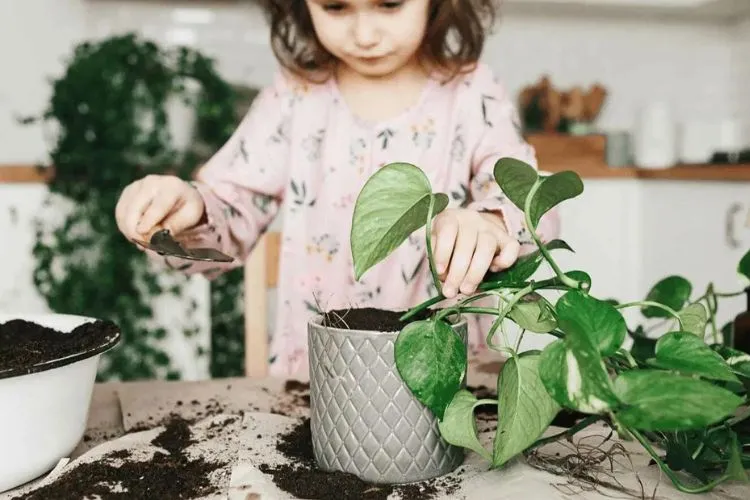
At the crux of a thriving pothos plant is its root system. Roots need a balanced environment—moist but not soggy, aerated but not dry.
And this is where the pot and its drainage come into play. Without adequate drainage, water tends to accumulate at the bottom of the pot, leading to root rot, stunted growth, and you guessed it—those excess water droplets we often see.
Common Potting and Drainage Mistakes:
- No Drainage Holes: A pot without drainage holes is like a house without windows. It traps excess water, leaving roots submerged and deprived of oxygen.
- Wrong Soil Mix: Using a dense soil mix that retains too much water can be counterproductive, even if your pot has drainage holes.
- Overpotting: Planting your pothos in an overly large pot might seem like a good idea, giving it room to grow. However, more soil means more water retention, which can lead to overwatering without even realizing it.
Tips for the Right Potting Experience:
- Pick the Right Pot: Always choose pots with ample drainage holes. If you’re fond of decorative pots without holes, consider using them as an outer shell with a well-draining pot inside.
- Soil Matters: Opt for a well-draining potting mix, often labeled for indoor or tropical plants. These mixes allow water to drain efficiently while retaining the necessary moisture.
- Consider Pot Size: When repotting, choose a pot that’s only an inch or two larger in diameter than the current one. This ensures the soil doesn’t hold excessive water.
- Elevate Your Pots: Placing a tray or saucer under your pot is good, but consider elevating the pot slightly. This ensures any excess water drains out and doesn’t get reabsorbed.
- Regularly Check Drainage: Occasionally check to ensure the drainage holes are not clogged with debris or compacted soil.
Root System Problems
The roots of any plant, pothos included, are its lifeline. Hidden away beneath the soil, these intricate networks are tirelessly working, drawing in water and nutrients essential for the plant’s growth. But like any system, they can encounter issues.
Let’s venture below the surface to understand root-related challenges that might make your pothos weep.
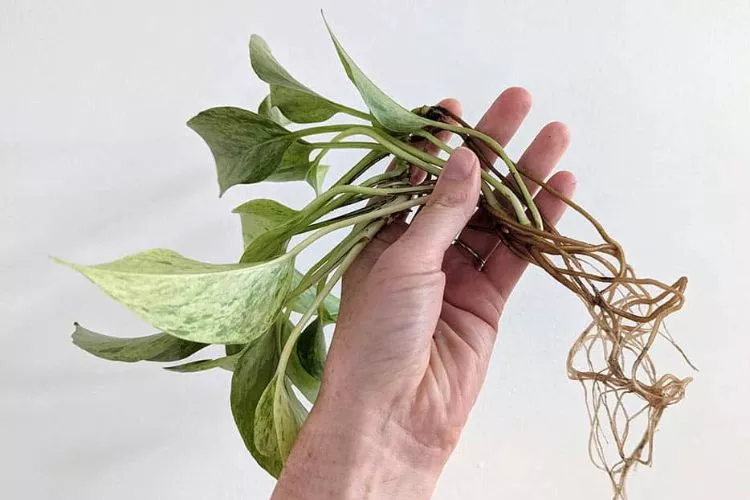
One of the main culprits behind root troubles is root rot. Root rot is the bane of many indoor plants and can quickly turn a thriving pothos into a wilting mess.
Essentially, it’s a fungal disease that affects the roots, turning them from a healthy white or light tan to a dark, mushy brown. This rot impairs the plant’s ability to absorb water and nutrients, often leading to those perplexing water droplets on the leaves.
Root Rot and Water Dynamics:
- Impaired Absorption: Rotten roots struggle to draw water, leaving the soil overly damp.
- Uneven Distribution: Even if some roots are healthy, they can’t compensate for the rotten ones, leading to unequal water distribution in the plant.
- Stress Reaction: The plant, sensing its roots are in trouble, might push out excess water through guttation as a stress reaction.
Assessing and Resolving Root Troubles:
- Visual Inspection: Every few months, gently ease your pothos out of its pot and inspect the roots. Healthy roots are firm and light-colored. Dark, mushy, or foul-smelling roots are a sign of rot.
- Trim the Damage: If you spot root rot, use sterilized scissors or pruners to trim away the affected parts, ensuring only healthy roots remain.
- Re-pot with Fresh Soil: Once you’ve addressed the root rot, plant your pothos in fresh, well-draining soil. This not only gives the roots a fresh start but also reduces the risk of reinfection.
- Limit Water: Until your pothos fully recovers, cut back on watering. Ensure the soil is dry at least an inch down before the next water session.
- Improve Ventilation: Increased airflow around your plant and its pot can deter fungal growth. Consider placing a fan nearby or ensuring the plant is in a well-ventilated area.
Root troubles can be disheartening, especially when you’re doing everything to provide the best care. But understanding the underlying issues and addressing them proactively ensures your pothos bounces back, stronger and more vibrant than before.
Always remember, every plant problem is a learning experience, making you a better plant parent with each challenge.
How to Resolve Pothos Dripping Water Issue?
We’ve ventured deep into understanding the ‘why’ behind the mystifying droplets on our beloved pothos. But knowing the reasons is just one half of the equation.
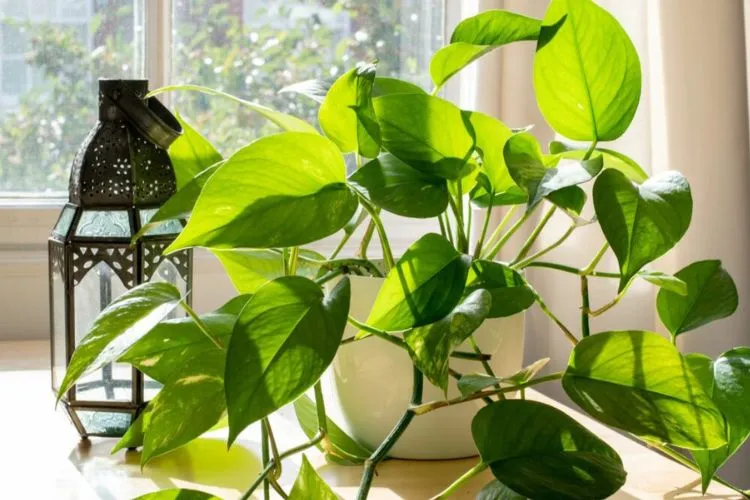
Now, let’s arm ourselves with the tools, tricks, and strategies to ensure our plants are not just surviving, but thriving. As we embark on this journey of resolution, remember, our leafy companions are resilient.
With a bit of love, care, and the right tactics, you can transform that dripping pothos into a beacon of indoor plant health. Let’s dive into the solutions, shall we?
Adjusting Watering Schedule
Watering, while seemingly simple, is a nuanced art when it comes to caring for pothos. It’s about harmonizing with the plant’s rhythm, discerning its needs, and responding appropriately.
By tapping into the subtle cues the plant offers, we can fine-tune our watering habits to foster optimal health. Let’s explore how to refine this essential aspect of care:
- Soil’s Story: Instead of adhering rigidly to a calendar, focus on the soil. If the top inch (2.5 cm) is dry, it’s watering time. If still damp, give it a day or two. Your touch is a vital gauge.
- Watering Wisdom: Aim for even watering, ensuring moisture permeates the soil without oversaturating. Should any water remain in the saucer under the pot, dispose of it post-watering.
- Seasonal Sensibility: Seasons dictate a plant’s thirst. Warmer, growing months may call for more frequent watering, whereas winter months might necessitate restraint.
- Environment’s Role: The atmospheric conditions of your home, whether it’s dry due to heating or humid because of cooling systems, can influence your pothos’s watering needs. Stay observant.
- Pot and Size Dynamics: A bigger pot retains moisture longer than a smaller counterpart. Similarly, the type of pot, be it ceramic or terracotta, can affect moisture retention. Keep these nuances in mind.
Tips to Avoid Overwatering:
Overwatering is the bane of many a houseplant enthusiast. Rooted in our well-meaning intentions to care, it’s a trap easy to fall into but essential to avoid.
- Embrace Minimalism: Pothos are resilient. A touch of neglect, in terms of underwatering, is more tolerable than the adverse effects of excess moisture.
- Escape the Calendar Trap: Don’t water just because the calendar dictates. Let your plant’s condition be your guide.
- Sign Spotting: Yellow leaves, especially those at the plant’s base, or a distinct musty odor are often red flags signaling overhydration.
- Prioritize Drainage: Effective drainage is crucial. It not only mitigates overwatering risks but also guards against potential root rot scenarios.
Engaging with our pothos is akin to a delicate dance. It’s a mutual journey where cues are given and taken, rhythms matched, and steps adjusted.
With attentive care, understanding, and adaptability, we ensure our dance with the pothos is a graceful, thriving, and harmonious one.
Managing Humidity Levels
Humidity plays a pivotal role in the well-being of our beloved pothos. Originating from tropical rainforests, these plants thrive in environments with adequate humidity.
However, in our homes, especially during certain seasons or in certain climates, maintaining optimal humidity can be challenging. The good news?
With some savvy techniques, we can create the ideal ambiance for our pothos to flourish.
- Understand the Needs: First things first, get to know the humidity levels your pothos craves. Typically, a humidity level ranging from 40% to 60% is ideal. Investing in a digital hygrometer can help you keep a close eye on the levels in your home.
- Grouping Plants: One of the most natural ways to boost humidity is to group plants together. As plants transpire, they release moisture, creating a micro-environment of higher humidity. Your pothos will surely appreciate the company!
- Water Tray Technique: Place a tray with water and pebbles beneath your pothos pot. As the water evaporates, it increases humidity around the plant. Just ensure the pot doesn’t sit directly in the water, which can cause root issues.
- Regular Misting: A simple spray bottle can work wonders. Misting your pothos leaves occasionally can up the humidity and also keep the foliage clean.
- Invest in a Humidifier: For a more hands-off approach, consider getting a humidifier. These devices can significantly elevate the moisture level in the air, making it a boon during dry winters. On the flip side, if you reside in an exceedingly humid area, a dehumidifier might be worth considering to prevent mold growth and other complications.
- Shower Time: Occasionally, giving your pothos a gentle shower can be beneficial. Not only does it increase humidity momentarily, but it also cleans the leaves, allowing them to breathe better.
Remember, the aim isn’t just about upping the moisture. It’s about creating a stable environment where the humidity level remains consistent. Rapid fluctuations can be stressful for plants.
Addressing Potential Infestations
Ah, pests! Every plant enthusiast’s bane. These tiny invaders, while minute in stature, can spell big problems for our cherished pothos. Some pests are particularly notorious for promoting excessive moisture, creating an environment where issues like water drippings might manifest.
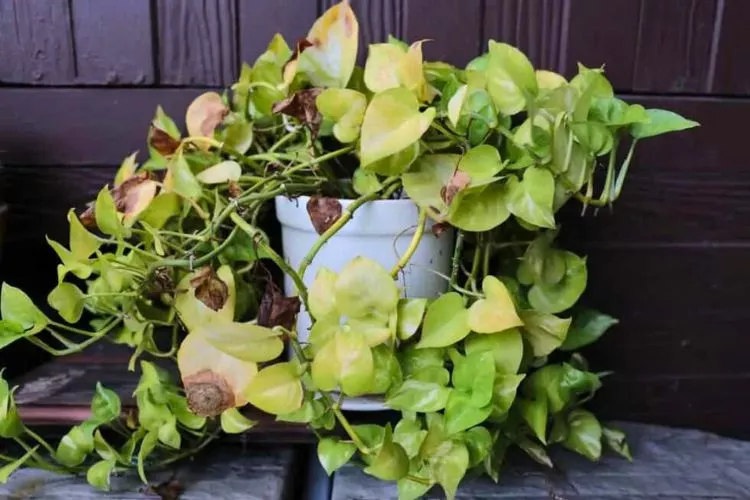
Let’s dive into understanding these pests and strategizing against them.
- Pesky Pests and Moisture: Certain pests, such as aphids and spider mites, are known to excrete a sticky substance called honeydew. This sugary secretion can lead to excessive moisture on leaves, making the plant more susceptible to sooty mold and other complications.
- Detective Mode: Vigilance is key. Regularly inspect the undersides of leaves, stems, and even the soil. Keep an eye out for signs like webbing, discoloration, sticky residues, or the pests themselves. Remember, early detection is half the battle won.
- Natural Predators: Beneficial insects like ladybugs or predatory mites can be nature’s answer to pest issues. They’re a non-chemical solution and can naturally reduce pest populations.
- Neem Oil: This organic solution is a gardener’s staple. It’s not only effective against a variety of pests but also acts as a fungicide. A diluted neem oil spray can keep many pests at bay.
- Insecticidal Soaps: Specifically designed for plants, these soaps break down the outer shells of pests, effectively tackling infestations. Ensure you follow label instructions.
- Quarantine New Plants: Always a good practice. Whenever you introduce a new plant into your space, keep it separate for a couple of weeks. This can prevent potential pest transfers to your existing plants.
- Regular Cleaning: A simple act, but often overlooked. Keeping your pothos leaves clean can deter pests. Wipe the leaves with a damp cloth periodically. Not only does this keep pests away, but it also ensures optimal photosynthesis.
Tackling pests requires a blend of attentiveness, patience, and timely intervention. The aim is to create an environment inhospitable to them while ensuring the well-being of our pothos.
Adjusting Lighting and Ventilation
Light and air: two fundamental elements of life. For our pothos plants, these elements hold the key to their vitality and overall health.
Striking the right balance in lighting and ventilation ensures not just a thriving pothos but also one that’s less likely to drip water. Let’s delve into the dynamics of these two factors and how they impact our plants.
- The Lighting Lowdown: Pothos, often celebrated for its adaptability, can thrive in various light conditions, from low to bright indirect light. However, direct sunlight can scorch its leaves, causing them to turn yellow or develop unsightly brown patches. The trick is to ensure your plant gets adequate but diffused light.
- Indirect Bright Light: A spot near an east or north-facing window works wonders. If you have only south or west-facing windows, consider using curtains or blinds to diffuse the harsh rays.
- Artificial Lighting: Pothos is also adaptable to fluorescent lighting, making it a favorite for office spaces.
- Ventilation Vibes: Proper ventilation not only deters pests but also aids in the evaporation of excess water. Stagnant, humid air can promote mold growth and extend the time leaves remain wet after watering.
- Natural Airflow: Regularly opening windows, if feasible, can introduce fresh air and reduce indoor humidity.
- Fans: A ceiling or oscillating fan on a low setting can promote good air circulation. Just ensure it’s not directly aimed at the plant to prevent excessive drying.
- Avoiding Extreme Conditions: Pothos is robust, but like all plants, it has its limits.
- Sunburn Alert: Ensure the plant is never exposed to direct sunlight for prolonged periods. If you spot leaves turning pale or yellow, it might be an indication of too much light.
- Drought Watch: While pothos can tolerate some neglect, consistent under-watering can lead to drought stress. Ensure a balanced watering routine, especially if the plant is in brighter light, which can dry out the soil faster.
Repotting Pothos Plants
Repotting—often likened to giving your beloved plant a new, spacious home. While the pothos is a rather easy-going resident, there are moments in its life where a change of abode becomes inevitable.
So, when and how do we embark on this relocation journey? Let’s delve into the nuances of repotting the ever-resilient pothos.
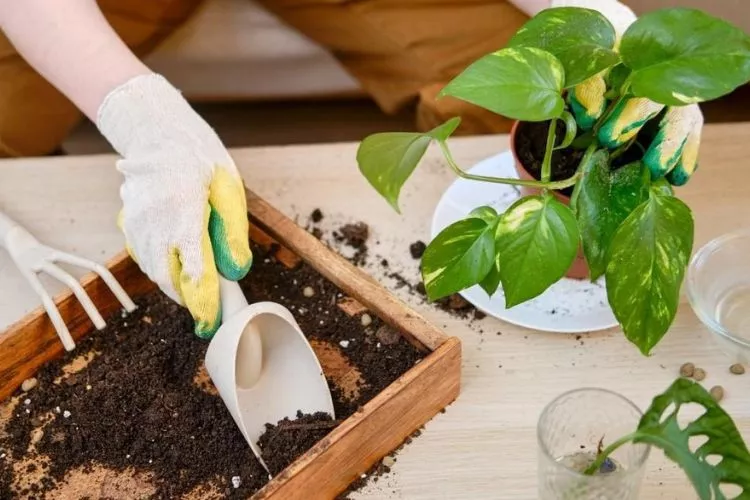
- Reasons for Repotting:
- Growth Spurts: As your pothos matures and sprawls, its roots need more room to spread and anchor. A larger pot ensures continued growth without restrictions.
- Compacted Soil: Over time, soil can become dense and lose its aerating properties, affecting root health and water absorption.
- Exhausted Nutrients: Old soil might get depleted of essential nutrients, necessitating a fresh mix for optimal growth.
- The Telltale Signs:
- Root Crowding: If you see roots emerging from the drainage holes or circling the surface of the soil, it’s a clear signal for more space.
- Water Woes: Water sitting on the soil surface or draining out too quickly can indicate compacted soil and poor root health.
- Stunted Growth or Yellowing: If your pothos appears stagnant in growth or has yellowing leaves despite good care, it might crave a new pot.
- The Repotting Ritual:
- Preparation: Choose a pot that’s 1-2 inches (2.5-5 cm) larger in diameter than the current one. Ensure it has ample drainage holes.
- Loosen Up: Gently tease out the roots from the old pot. Examine them, trimming away any that are rotten or overly tangled.
- Fresh Soil: Use a well-draining potting mix, ideally suited for pothos or similar tropical plants. Fill the new pot with some soil, positioning the plant so its roots are spread out and it sits at the same depth as before.
- Settle In: Add soil around the roots, pressing gently to eliminate air pockets. Water the plant thoroughly, allowing any excess to drain.
Repotting might seem like a monumental task, but with the right knowledge and gentle hands, it’s a rejuvenating experience for your pothos. Consider it a rite of passage, a celebration of growth, and an investment in many more years of verdant beauty.
Frequently Asked Questions (fAQs)
Why is my pothos dripping water in the morning?
Morning dripping in pothos is often due to guttation, a process where excess water is exuded from leaf tips, especially after night transpiration.
Can guttation be harmful to pothos plants?
No, guttation is a natural process. However, frequent guttation might indicate overwatering or poor soil drainage, which can be detrimental.
How often should I water my pothos to prevent water dripping?
Water pothos when the top 1-2 inches (2.5-5 cm) of soil feels dry. Overwatering can cause dripping and other health issues. Adjust based on season and environment.
Conclusion
In wrapping up, understanding why your pothos drips water is crucial. Whether it’s due to humidity, overwatering, pot issues, or natural processes like transpiration and guttation, being informed is half the battle.
The solutions provided here are your arsenal for a thriving pothos.
Remember, every plant speaks; listening and responding is our job. We hope that this guide has been helpful. You can read about similar topics here on our website. Check back again soon for more.


